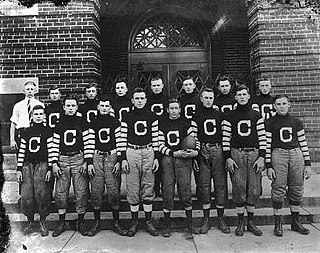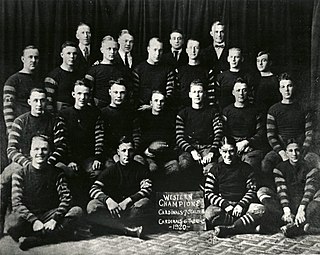Related Research Articles

The Cincinnati Celts was the first professional football team to play in Cincinnati, Ohio. The team played in the unofficial "Ohio League" and the American Professional Football Association. The Celts were a traveling team, playing all of their APFA games in other cities' stadia. In its only season in the APFA, 1921, the team had a record of 1–3. For the entire span of the team's existence, the Celts were coached by Mel Doherty, who was also the team's center.

The Muncie Flyers, known as the Congerville Flyers for most of their existence, were a professional American football team from Muncie, Indiana, that played from 1905 to 1926. The Flyers were an independent squad for most of their existence, but are remembered mostly for their very brief stint in the American Professional Football Association. With only three official league games, one in 1920 and two in 1921, the Flyers are the third-shortest-lived team in league history, behind the two games of the original New York Giants and the one game of the Tonawanda Kardex Lumbermen, and the shortest by a team not from the state of New York.

The Rock Island Independents were a professional American football team, based in Rock Island, Illinois, from 1907 to 1926. The Independents were a founding National Football League franchise. They hosted what has been retrospectively designated the first National Football League game on September 26, 1920 at Douglas Park. The Independents were founded in 1907 by Demetrius Clements as an independent football club. Hence, the team was named the "Independents."
The New York Giants were a professional American football team with the American Professional Football Association whose only season played was in 1921. The team has also been referred to as the Brooklyn Giants and Brickley's Brooklyn Giants. The Brickley's Giants were the first of 17 professional football teams to represent New York City at one time or another. The team was founded in 1919 by Charles Brickley, who received All-American honors while at Harvard. Brickley's Giants played two games in their only season, losing to the Buffalo All-Americans, 55–0, and the Cleveland Tigers, 17–0. It was the second-shortest-lived franchise in APFA/NFL history, behind only another former New York APFA team, the Tonawanda Kardex, who played only one game in the same 1921 season.
The 1920 APFA season was the inaugural season of the American Professional Football Association, renamed the National Football League in 1922. An agreement to form a league was made by four independent teams from Ohio on August 20, 1920, at Ralph Hay's office in Canton, Ohio, with plans to invite owners of more teams for a second meeting on September 17, 1920. The "American Professional Football Conference" (APFC) was made up of Hay's Canton Bulldogs, Akron Pros, the Cleveland Tigers and the Dayton Triangles, who decided on a six-game schedule to play each other at home-and-away, an agreement to respect each other's player contracts, and to take a stand against signing college students whose class had not yet graduated.

The 1920 season was the Decatur Staleys 2nd season of existence, the first professional season of the franchise that would go on to be known as the Chicago Bears and their first under head coach George Halas, competing in the newly formed American Professional Football Association.

The 1920 Akron Pros season was the franchise's inaugural season with the American Professional Football Association (APFA) and twelfth total season as a team. The Pros entered the season coming off a 5–5 record in 1919 as the Akron Indians in the Ohio League. The Indians were sold to Art Ranney and Frank Nied, two businessmen, to help achieve a better record and crowd. Several representatives from the Ohio League wanted to form a new professional league; thus, the APFA was created.
The 1920 Buffalo All-Americans season was the franchise's inaugural season with the American Professional Football Association (APFA), an American football league, and fifth total as a team. The All-Americans entered 1920 coming off a 9–1–1 record in 1919 as the Buffalo Prospects in the New York Pro Football League (NYPFL). Several representatives from another professional football league, the Ohio League, wanted to form a new national league, and thus the APFA was created.

The 1920 Canton Bulldogs season was the franchise's sixteenth and its first in the American Professional Football Association (APFA), which became the National Football League two years later. Jim Thorpe, the APFA's president, was Canton's coach and a back who played on the team. The Bulldogs entered the season coming off a 9–0–1 performance as Ohio League champions in 1919. The team opened the season with a 48–0 victory over the Pitcairn Quakers, and finished with a 7–4–2 record, taking eighth place in the 14-team APFA. A then-record crowd of 17,000 fans watched Canton's week 12 game against Union AA of Phoenixville.

The 1920 Chicago Cardinals season was the Cardinals' inaugural season in the American Professional Football Association. The team finished 6–2–1, earning fourth in the league. Their final two games of the season against the Chicago Stayms Foresters were played after the APFA season was officially over and did not count towards the standings.
The 1920 Cleveland Tigers season was the franchise's inaugural season in the American Professional Football Association (APFA) and fifth total as an American football team. The Tigers entered the season coming off a 5-win, 2-loss, 2-tie (5–2–2) record in 1919. After the 1919 season, several representatives from the Ohio League, a loose organization of professional football teams, wanted to form a new professional league; thus, the APFA was created.
The 1920 Columbus Panhandles season was the franchise's inaugural season in the American Professional Football Association (APFA)—later named the National Football League. The season concluded with the team going 2–6–2 and finishing 13th place in the APFA standings. The Panhandles entered the season after a 3–6–1 record in 1919. The team opened the 1920 season with a loss to the Dayton Triangles, and the Panhandles lost five straight until a victory over the Zanesville Mark Grays. Not a single player was on the All-Pro list.
The 1920 Dayton Triangles season was the franchise's inaugural season in the American Professional Football Association (AFPA)—later named the National Football League. The Triangles entered the season coming off a 5–2–1 record in 1919 in the Ohio League. After the 1919 season, several representatives from the Ohio League wanted to form a new professional league; thus, the APFA was created. A majority of the team stayed from the 1919 team, including the coaching staff, while two players left the team.
The 1920 Hammond Pros season was the franchise's inaugural season in the American Professional Football Association (APFA) and second as an American football team. The Pros entered 1920 coming off a 4-win, 2-loss, 3-tie (4–2–3) record in 1919 as an independent team. Several representatives from another professional football league, the Ohio League, wanted to form a new national league, and thus the APFA was created.
The 1920 Muncie Flyers season was the franchise's inaugural season in the American Professional Football League (APFA)—later named the National Football League. The Flyers entered the season coming off a 4–1–1 record in 1919. Several representatives from the Ohio League wanted to form a new professional league; thus, the APFA was created. The 1920 team only played in one game that counted in the standings: a 45–0 loss against the Rock Island Independents. This game and the Columbus Panhandles–Dayton Triangles on the same date is considered to be the first league game featuring two APFA teams. The Flyers tried to schedule other games, but the opponents canceled to play better teams. As a result, the Flyers had to play the rest of the season's game versus local teams. In week 10, the Flyers won a game against the Muncie Offers More AC for the Muncie City Championship. No players from the 1920 Muncie Flyers were listed on the 1920 All-Pro Team, and no player has been enshrined in the Pro Football Hall of Fame.
The 1920 Rochester Jeffersons season was the franchise's inaugural season in the American Professional Football Association (APFA) and thirteenth as an American football team. The Jeffersons entered 1920 coming off a six-win, two-loss, two-tie (6–2–2) record in the New York Pro Football League (NYPFL) where it lost the championship game to the Buffalo Prospects. Several representatives from another professional football league, the Ohio League, wanted to form a new national league, and thus the APFA was created.
The 1920 Rock Island Independents season was the American football franchise's thirteenth season and inaugural season in the American Professional Football Association (APFA). The Independents hosted first ever APFA/National Football League contest on September 26, 1920. After the AFPA had been formed on September 17, 1920, Douglas Park was the venue as the Independents hosted the St. Paul Ideals, winning 48-0 in the new league's first contest.

Brunswick-Balke-Collender Cup was a silver trophy donated to the American Professional Football Association by the Brunswick-Balke-Collender Company, Tire Division.

Alfred Russell Cobb was an American college and professional football player. Cobb played college football for Syracuse University, and later played professionally in the National Football League (NFL).
References
- Hogrogian, John (1984). "1920 All-Pros" (PDF). The Coffin Corner . 6 (1). Professional Football Researchers Association. Archived from the original (PDF) on August 8, 2014.
- 1920 APFA All-Pros